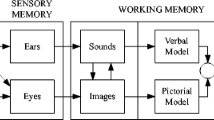Abstract
This research attempts to explore and elucidate the potential applications of educational technologies such as ICT and ubiquitous computing technologies in solving core domain problems that exist in lectures of higher education. This article emphasizes the importance of student-centric awareness in an effective teaching system. Apart from the continuously integrated and updated personal profile, non-verbal communication such as students’ body-talk reaction is one of the important elements of reading and understanding students in the classroom. In the proposed effective teaching system, student facial expression and sitting posture are continuously monitored and analyzed, based on the applicable set of effective teaching support agents are employed to support a teacher to make a conclusion, take an action, or automatically involve in the teaching process.
Access this chapter
Tax calculation will be finalised at checkout
Purchases are for personal use only
Similar content being viewed by others
References
Simpson AW, Erickson MT (1983) Teachers’ verbal and nonverbal communication patterns as a function of teacher race, student gender, and student race. Am Educational Res J 20(2):183–198
Ruth BC, Saba A-N, Shahrzad M (2004) The role of gesture in Bilingual education: does Gesture enhance learning? Int J Bilingual Edu Bilingualism 7(4):303–319
Jolly S (2000) Understanding body language: Birdwhistell’s theory of kinesics. Corp Comm Int J 5(3):133–139
Philip G (2007) Five factors for effective teaching. New Zealand J Teach Work 4(2):89–98
Verdejo MF, Celorrio C, Lorenzo E, Sastre T (2006) An educational networking infrastructure supporting ubiquitous learning for school students. In: Advanced learning technologies, 2006. Sixth international conference on, 2006, pp 174–178
Huang R, Ma J, Jin Q (2010) An agent based approach for promoting interactive teaching and active learning. In: Information technology based higher education and training (ITHET), 2010 9th international conference on, 2010, pp 349–354
El-Bishouty MM, Ogata H, Yano Y (2008) A model of personalized collaborative computer support ubiquitous learning environment. In: Advanced learning technologies, 2008. ICALT’08. Eighth IEEE international conference on, 2008, pp 97–101
Scheele NK (2006) The interactive lecture: a new teaching paradigm based on pervasive computing. Univeristy of Mannheim, Germany
Kopf S, Effelsberg W (2007) New teaching and learning technologies for interactive lectures. Adv Technol Learn 4:60–67
Herreid CF (2006) ‘Clicker’ cases: introducing case study teaching into large classrooms. J College Sci Teach 36(2):43–47
Kajita S, Mase K (2006) uClassroom: expanding awareness in classroom to ubiquitous teaching and learning. In: Fourth IEEE international workshop on wireless, mobile and ubiquitous technology in education, 2006. WMUTE’06, 2006, pp 161–163
Ku OY, Huang OW, Chan T-W (2008) Teacher monitoring system in one-to-one self-paced learning classroom. In: Fifth IEEE international conference on wireless, mobile, and ubiquitous technology in education, 2008. WMUTE 2008, pp 196–198
Roblyer MD, Wiencke WR (2003) Design and use of a rubric to assess and encourage interactive qualities in distance courses. Am J Distance Edu 17(2):77–98
Lin K-C, Lin R-W, Chen S-J, You C-R, Chai J-L (2010) The classroom response system based on affective computing, in 2010 3rd IEEE international conference on ubi-media computing (U-Media), 2010, pp 190–197
Kasiran Z, Ibrahim Z, Yahya S (2008) Facial expression recognition as an implicit customers’ feedback, Advances in human-computer interaction, Oct 2008
Ekman P, Friesen WV, Hager JC (2011) Facial action coding system—the manual. [Online]. Available: http://face-and-emotion.com/dataface/facs/manual/TitlePage.html. Accessed: 03-Jul-2011
Bradski G, Kaehler A (2008) Learning OpenCV: computer vision with the OpenCV library, 1st edn. O’Reilly Media, 2008
Turk M, Pentland A (1991) Eigenfaces for recognition. J Cognit Neurosci 3(1):71–86
Kobayashi H, Hara F (1992) Recognition of Six basic facial expression and their strength byneural network. In: IEEE international workshop on robot and human communication, Proceedings, 1992 pp 381–386
Tammy SG (2007) Language learning beyond words: incorporating body language into classroom activities. J Reflect Engl Lang Teach 6(1):51–64
Stires L (1980) Classroom seating location, student grades, and attitudes. Environ Behav 12(2):241–254
Neff M, Wang Y, Abbott R, Walker M (2010) Evaluating the effect of gesture and language on personality perception in conversational agents. In: Proceedings of the 10th international conference on intelligent virtual agents. Heidelberg, Berlin, pp 222–235
Classics in the history of psychology—Jung (1921/1923) Chapter 10. [Online]. Available: http://psychclassics.yorku.ca/Jung/types.htm. Accessed: 25-Jul-2011
Microsoft Kinect SDK for developers| develop for the Kinect | Kinect for windows. [Online]. Available: http://kinectforwindows.org/. Accessed: 14-Nov-2011
Author information
Authors and Affiliations
Corresponding author
Editor information
Editors and Affiliations
Rights and permissions
Copyright information
© 2013 Springer Science+Business Media New York
About this paper
Cite this paper
Shminan, A.S., Huang, R. (2013). The Influence of Student Body-Talk Reaction in Formulating Effective Teaching Strategy. In: Elleithy, K., Sobh, T. (eds) Innovations and Advances in Computer, Information, Systems Sciences, and Engineering. Lecture Notes in Electrical Engineering, vol 152. Springer, New York, NY. https://doi.org/10.1007/978-1-4614-3535-8_68
Download citation
DOI: https://doi.org/10.1007/978-1-4614-3535-8_68
Published:
Publisher Name: Springer, New York, NY
Print ISBN: 978-1-4614-3534-1
Online ISBN: 978-1-4614-3535-8
eBook Packages: EngineeringEngineering (R0)




